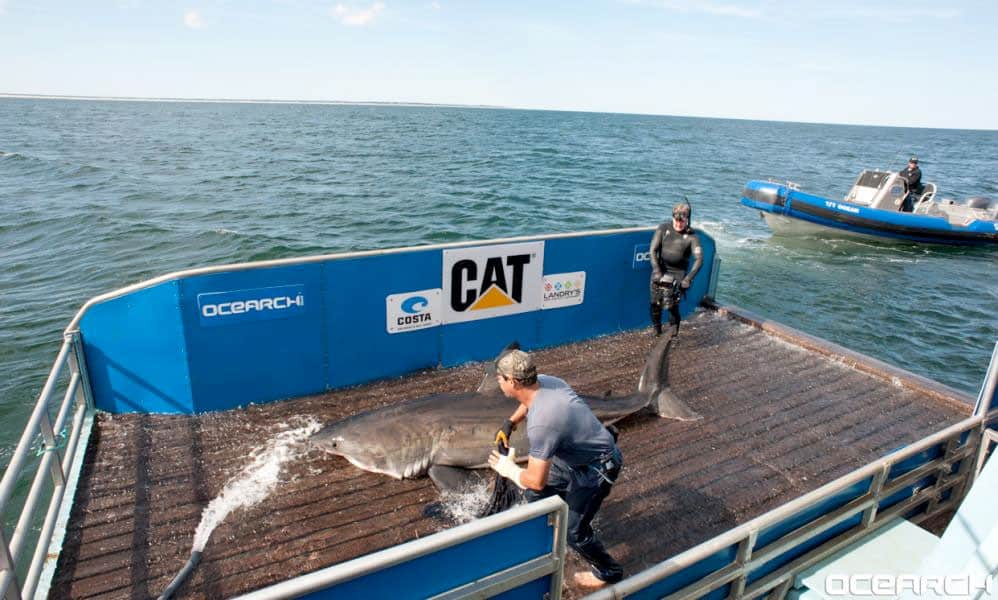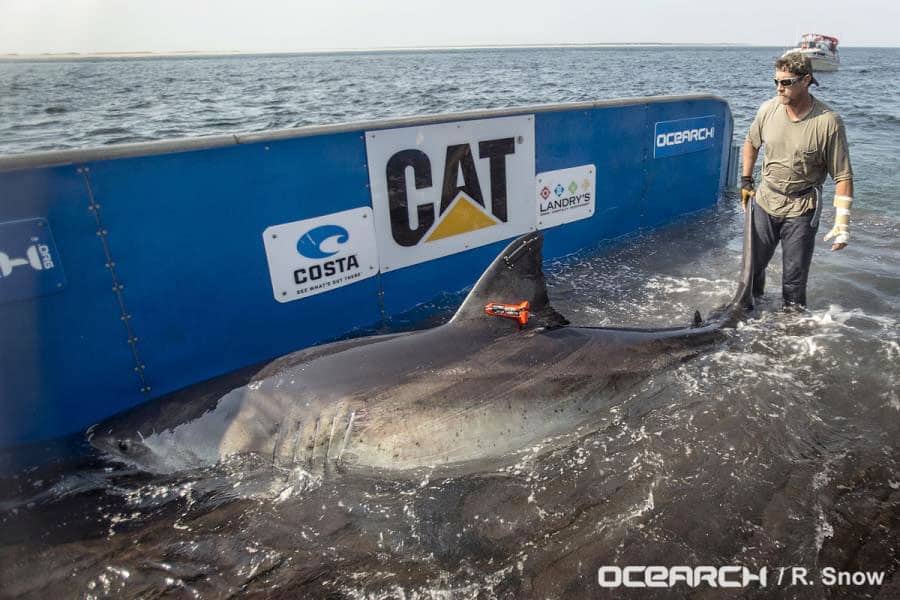• by Dr. Sarah Oktay, Director, University of Massachusetts Nantucket Field Station •

They’re back! Two great white sharks tagged in 2013 have returned to our waters over the past week. Katharine and Betsy were tagged by scientists with the well-known Massachusetts based shark research group OCEARCH (http://www.ocearch.org/) in August of last year and within a little more than one year have returned to our shores. Although many people are concerned about both the return of the gray seals and great whites, it is important to remember that the great white sharks and many other shark species are apex predators (like humans) which are, as the name implies, the top predator in the food web. In other words, these creatures are the lions of the sea and they help maintain ecosystem balance. If we remove top predators, we would disrupt the delicate balance of the food web. It is a success story that they have returned and despite some high profile incidents between humans and sharks, their return has increased tourism on the Cape (http://www.nytimes.com/2014/07/28/us/sharks-in-cape-cod-town-draw-tourists-flipping-the-jaws-script.html?_r=0 ). Much of the credit for the love versus hate relationship that people feel toward white sharks can be attributed to Dr. Greg Skomal who has spent the past several years educating the public about the value and beauty of these animals.
I have written about the recovery of the gray seal population (Halichoerus grypus) several times. Back in 2009 (http://yesterdaysisland.com/archives/science/13.php) I wrote about the types of sharks found in our waters and described the times of year we would most likely see them. In Massachusetts we see a variety of shark species including blue, mako, angel, basking (huge sharks often mistaken for great whites), dusky, porbeagle, sandbar, sand tiger, smooth and spiny dogfish, thresher, sharpnose, tiger and hammerheads (relatively rare tropical species), and the iconic great white shark (scientists just call them white sharks). In the summer of 2011 I also wrote about Fin 101; how to identify a shark fin and distinguish it from sunfish and dolphins and other finny creatures (http://yesterdaysisland.com/the-boy-who-cried-shark-fin-sighting-101/). A larger gray seal population does attract great white sharks, but it is not like the ocean is teaming with them. I was asked recently how many great whites were in a given area with the person questioning me thinking the number was in the hundreds. My educated guess was that there were perhaps 2-5 great white sharks within 10 miles of Nantucket.
From the OCEARCH website “OCEARCH is a non-profit organization with a global reach for unprecedented research on great white sharks and other large apex predators. In a collaborative environment established by Founding Chairman and Expedition Leader Chris Fischer, OCEARCH enables leading researchers and institutions to generate previously unattainable data on the movement, biology and health of sharks to protect their future while enhancing public safety and education.”
OCEARCH has quickly improved the amount of science that can be done and there shark tracking apps and program allow the public to be engaged in a real and wonderful way. For instance by going to the website and zooming in on Nantucket we can see that Betsy, who was tagged in August of 2013, was just off the coast of Sconset on September 27tth at 3:43 pm! It is important to note that Betsy just returned a few days ago, she hasn’t been circling all summer and these tagging programs help us understand shark behavior while assuring us of when they are or are not, on our doorstep. Katharine just surfaced and a ping was recorded on September 27th at 5:41 am several miles southeast of Nantucket. Tagging allows scientists to follow these sharks as they migrate down to Florida and around to the Gulf of Mexico. During the tagging operations, various scientist are allowed a brief time with the animals (15 minutes max for all onboard work) to take blood and tissue samples. Our ability as scientists to work with live creatures and return them to the wild to observe them naturally has increased by leaps and bounds.
Speaking of big and getting bigger: Katharine is the larger of the two sharks, weighing in at 2,300 pounds at the time of her tagging. At that time she was 14’ 2” long but scientists following her say she has most likely grown since then. For comparison, the largest ever recorded great white was 21 feet long; except when you dig deeper and you discover that sharks shrink a lot after death and that it is hard to tell how big they can get, with twenty feet more likely the max (more at http://www.discovery.com/tv-shows/shark-week/about-this-show/largest-great-white-shark.htm) . The second shark, Betsy, is also likely to be bigger now (aren’t we all, well, except for those high achievers on the oceanic treadmills). Tagged one day before Katharine, she weighed 1,400 pounds and measured 12’ 7”.

The majority of sharks in our waters are gentle giants who would much rather be eating plankton, a sand lance, or other small prey fish. In Massachusetts, there have been four reported unprovoked shark attacks from 1670-2012, three of which were fatal, with the last fatal attack occurring in 1936. Except for sport fishing, there are no major commercial fisheries for sharks except trawl and gillnet fisheries for spiny dogfish (according to the Division of Marine Fisheries website). Of the 5.7 million pounds of shark landed in the Commonwealth in 2000, 99% were spiny dogfish with a commercial value of $1.3 million. The remaining 1% was primarily makos, threshers, and porbeagles taken incidental to offshore trawl, longline, and gillnet fisheries based in this state.
“Friend of the Nantucket Field Station” (more entertaining if you think of it along the lines of “Friend of the Show” from Steven Colbert) Massachusetts shark expert Dr. Greg Skomal has worked with both with the OCEARCH team and with Atlantic White Shark Conservancy (found at http://www.atlanticwhiteshark.org/#welcome) . He also heads up the Massachusetts Shark Research Program for the Massachusetts Division of Marine Fisheries. In 2009, Greg and John Chisholm were the first to successfully tag and track great whites in the Northwest Atlantic Ocean using high tech tags (official data and updates at http://www.mass.gov/dfwele/dmf/spotlight/white_shark_2010.htm).
From the Atlantic White Shark Conservancy website (http://www.atlanticwhiteshark.org/research/) we learn that: “In the Northwest Atlantic Ocean, the white shark population is estimated to have declined by over 75% in the past 15 years (Baum et al., 2003). Cape Cod has become an aggregation site for great white sharks, presenting a rare and incredible research opportunity.
“For the first time, modern scientists have predictable access to white sharks in the North Atlantic and the ability to study their life history and ecology over multiple spatial and temporal scales,” explains leading shark expert, Dr. Greg Skomal. “Without a strong sense of how many white sharks exist in this area or how many are being killed, the time to act is now.”
Dr. Greg Skomal has been a senior fisheries biologist with Massachusetts Marine Fisheries since 1987 and he is also adjunct faculty at the University of Massachusetts School for Marine Science and Technology. I am also adjunct faculty there, although my research is not as exciting, I do not get to build robots to film sharks underwater. Greg’s shark research has spanned multiple fish habitats around the globe. Much of his current research centers on the use of acoustic telemetry, satellite-based technology, and animal-borne imaging to assess the physiological impacts of capture stress on the post-release survivorship and behavior of sharks. He is now looking at remote robot based tracking devices that can follow various tagged sharks including the basking sharks he is studying. Go here http://www.newenglandoceanodyssey.org/the-shark-tracker-an-interview-with-greg-skomal/ to learn about his work filming sharks using autonomous underwater vehicles also known as AUVs.
You can go to Cisco Brewery and buy some good light beer to support OCEARCH Shark Research. For every case sold, $3 goes to Chris Fischer and OCEARCH. If you scan the shark fin or the image of the OCEARCH research vessel (M/V OCEARCH) it will bring you to an app that shows you where their tagged sharks are. Last but not least, along the line of fun tidbits of knowledge, Katharine was named in honor of Katharine Lee Bates, a Cape Cod native and songwriter who is best known for her poem and song “America The Beautiful”.


